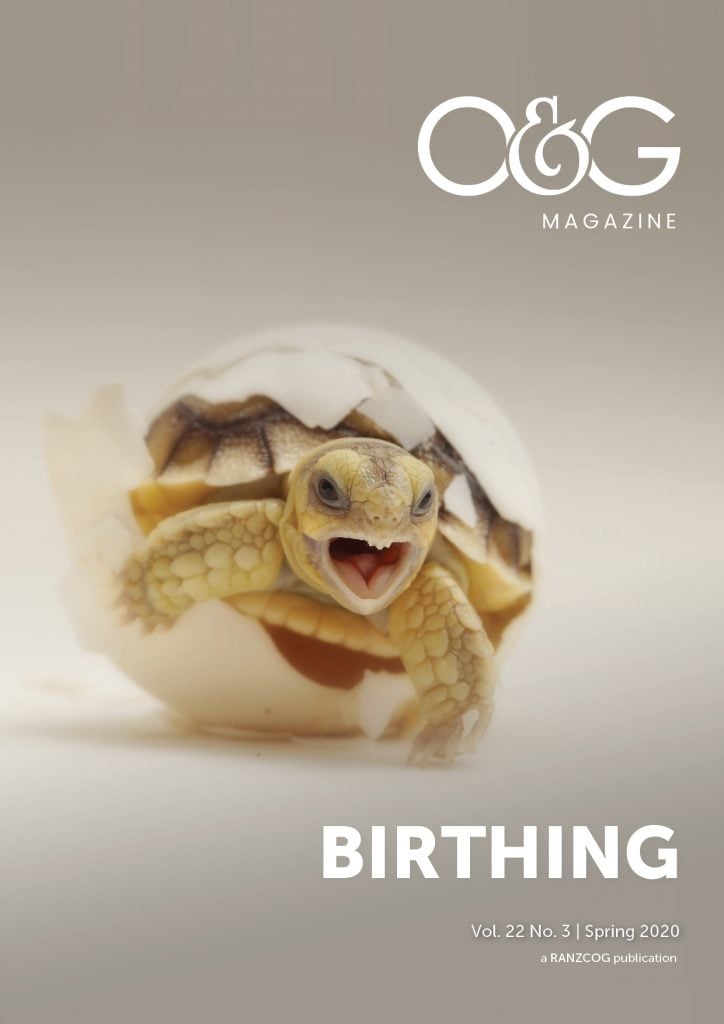When you move hospitals, let alone countries, you start to question any practice you used to take for granted. I trained in university hospitals in Toronto, Canada, then moved to Whangarei, NZ, then back to Canada to work at a suburban hospital, and now live and work in Auckland. I have noticed several trends in labour induction that made me look up the evidence to support or refute my practice. I also chaired the development of a clinical practice guideline on induction of labour for the Aotearoa New Zealand context1 presented via RANZCOG webinar (available from https://ranzcog.eventsair.com/cmspreview/ranzcog-webinar-nz/archives).
I have learned that (a) much of what we do has no high-quality research evidence to support best practice, so it is up to individual clinicians or hospital culture to decide, and (b) there is research to support some elements of labour induction but we still may not implement best practice for a variety of reasons. I would like to summarise the few areas that have moderate quality of evidence to support conditional recommendations, and pose some research questions that could lead to some feasible registrar projects. Finally, I will conclude that we should offer women several different methods of cervical ripening and labour induction and have a shared decision-making model to manage an individual woman’s care.
Which methods are supported by research evidence?
There is moderate-quality evidence that cervical ripening with prostaglandins probably improves the chance of vaginal birth within 24 hours for women with unfavourable cervix over oxytocin alone.2 Consequently, women with an unfavourable cervix should be offered cervical ripening to increase their Bishop score and hopefully improve their chances of a successful induction.
Some clinicians perform membrane sweeping at the same time as performing a formal labour induction. This is supported by several RCTs showing that concurrent membrane sweeping probably increases the rate of vaginal birth, shortens the induction to birth interval and reduces the exposure of mothers and babies to oxytocin.3
Some hospitals use vaginal PGE2 (dinoprostone) as their preferred prostaglandin. Comparing Cervidil® controlled-release pessary to Prostin® gel, there is moderate to high-quality evidence that these are similar to each other to achieve vaginal birth within 24 hours, with no difference in caesarean section.4 Thus, hospitals can offer either or both methods of administration.
Some hospitals use misoprostol, a PGE1 analogue, as their preferred prostaglandin. There is moderate-quality evidence that there is probably no difference in caesarean section rates between vaginal misoprostol and vaginal PGE2, or between oral misoprostol and vaginal PGE2.5 6Misoprostol is not approved for cervical ripening in the setting of induction of labour in NZ7 and use in childbirth is not an approved indication in Australia.8 However, the use of misoprostol in childbirth has been widely researched internationally and endorsed by the World Health Organization. It is supported for use in NZ.9 If your hospital is considering starting to use misoprostol, consult early with your pharmacy colleagues and local hospitals that have already been through this process.
Balloon catheters are a non-pharmacologic and inexpensive method of cervical ripening. In all trials reviewed here, the balloon catheter remained in situ for 12 hours. There is moderate-quality evidence that there is probably no difference in caesarean section or operative vaginal delivery between balloon catheters and prostaglandins. The main benefit of balloon catheter is that there is less risk of uterine hyperstimulation with fetal heart rate changes compared to prostaglandins.10 Although not evidence-based, it makes sense to offer this mechanical method to women where uterine hyperstimulation may be of greater consequence, such as women with previous caesarean section or babies with suspected small for gestational age. In some hospitals, interested midwives are being upskilrupture led to place balloon catheters, which is fantastic.
There is moderate-quality evidence that inflating the single-balloon catheter to more than 30mL probably results in a higher chance of birth within 24 hours compared to low inflation volume, with no difference in caesarean section.11 It makes sense to source a Foley balloon catheter that is intended to inflate to 50mL.
There seems to be little difference in mode of birth between single- or double-balloon catheters, but women with double-balloon catheters experienced more pain and less satisfaction.12 Hospitals can decide which balloon is preferred by hospital staff, accounting for cost.
Which methods are not supported by research evidence?
Regarding vaginal prostaglandin E2, there is insufficient evidence to make recommendations about duration and repeat doses of controlled-release pessary, nor about dose of gel by parity, repeat doses, total dose or time frame.
Regarding induction of labour for women with previous caesarean section, there is insufficient evidence to make recommendations about safety or effectiveness of any method.
Regarding early versus late artificial rupture of membranes (ARM)(e.g. starting oxytocin with delayed ARM), and combination of ARM/oxytocin versus ARM alone with delayed oxytocin, there is insufficient evidence to make recommendations about the order and timing of these two common induction methods.
Regarding oxytocin, there is insufficient evidence to make recommendations about starting dose, dosing interval, and maximal dose, nor about different protocols for nulligravida versus multipara, for women with previous caesarean section, or for induction versus augmentation.
Regarding setting of induction of labour, there is insufficient evidence to make recommendations about outpatient management. The PINC trial in Australia ended early and did not achieve enough power to show that outpatient balloon was safer for babies than inpatient prostaglandins.13 The OBLIGE trial in New Zealand is ongoing (www.oblige.auckland.ac.nz) and together these trials should better inform us about safety and effectiveness of outpatient balloon catheter induction for both mothers and babies. Some hospitals already offer outpatient balloon catheter induction – although a sensible approach, it’s not yet evidence-based.
Research questions
If a registrar approached me to discuss research questions that were important to answer and feasible to achieve within their training timeframe, I would suggest a randomised controlled trial design, with a population of women undergoing induction of labour at 37 weeks or more, with a primary outcome of vaginal birth. These would be my top three comparisons:
- For women with unfavourable cervix, starting dose of 1mg vs 2mg Prostin gel and next dose 1mg vs 2mg Prostin gel (stratify either by parity or by Bishop score)
- For women with unfavourable cervix after 12 hours of prostaglandins, either another 12 hours of prostaglandins, or swap to balloon catheter (12 hours in situ)
- For women with favourable cervix, either early ARM (prior to or within one hour of starting oxytocin) or late ARM (either 12 hours after starting oxytocin or after cervix 6cm dilated or more)
Conclusions
I would suggest that for hospital maternity services that are looking to update their guidelines, that they use the research evidence to underpin any recommendations and acknowledge those practice points that are not evidence based. For the latter, consider broad consultation with doctors, midwives and consumers, and make decisions based on preferences, resources and hospital culture. It makes sense to have one or two prostaglandins and one balloon on offer, with an accompanied decision aid or short video to help women choose based on risks and benefits, and values and beliefs.
If you are reading this in NZ, please consider participating in the OBLIGE research trial14 – as of the time of writing, we have recruited our 800th participant, towards a sample size of 1550. And if you are interested in a research project, there are so many ideas worth looking at; induction of labour research is feasible, given that one in four women in NZ have an induction.
References
- Wise MR, et al. Induction of labour in Aotearoa New Zealand; a clinical practice guideline, 2019. Available from: https://mhsfaculty.auckland.ac.nz/inductionNZ/
- Alfirevic Z, Kelly A, Dowswell T. Intravenous oxytocin alone for cervical ripening and induction of labour. Cochrane Database Syst Rev. 2009;4:CD003246.
- Liu J, Song G, Meng T et al. Membrane sweeping added to formal induction method to increase the spontaneous vaginal delivery: a meta-analysis. Arch Gynecol Obstet. 2018;297:623.
- Thomas J, Fairclough A, Kavanagh J, Kelly AJ. Vaginal prostaglandin (PGE2 and PGF2a) for induction of labour at term. Cochrane Database Syst Rev. 2014;6:CD003101.
- Alfirevic Z, Aflaifel N, Weeks A. Oral misoprostol for induction of labour. Cochrane Database Syst Rev. 2014;6:CD001338.
- Hofmeyr GJ, Gülmezoglu AM, Pileggi C. Vaginal misoprostol for cervical ripening and induction of labour. Cochrane Database Syst Rev. 2010;10:CD000941.
- Wise MR, et al. Induction of labour in Aotearoa New Zealand; a clinical practice guideline, 2019. Available from: https://mhsfaculty.auckland.ac.nz/inductionNZ/
- RANZCOG Statement. The use of misoprostol in obstetrics and gynaecology (C-Obs-12). 2016. Available from: https://ranzcog.edu.au/statements-guidelines/obstetrics/misoprostol-in-obstetrics,the-use-of-(c-obs-12).
- Wise MR, et al. Induction of labour in Aotearoa New Zealand; a clinical practice guideline, 2019. Available from: https://mhsfaculty.auckland.ac.nz/inductionNZ/
- Jozwiak M, Bloemenkamp KWM, Kelly AJ, et al. Mechanical methods for induction of labour. Cochrane Database Syst Rev. 2012;3:CD001233.
- Berndl A, El-Chaar D, Murphy K, Macdonald S. Does cervical ripening at term using a high volume foley catheter result in a lower caesarean section rate than a low volume foley catheter? A systematic review and meta-analysis. J Obstet Gynaecol Can. 2014;36(8):678-87.
- Salim R, Schwartz N, Zafran N, et al. Comparison of single and double balloon catheters for labour induction: a meta-analysis and systematic review of randomised controlled trials. J Perinatol. 2018;38:217-25.
- Beckmann M, Gibbons K, Flenady V, Kumar S. Induction of labour using prostaglandin E2 as an inpatient versus balloon catheter as an outpatient: a multicentre randomised controlled trial. BJOG. 2020;127:571-9.
- Wise MR, Marriott J, Battin M, et al. Outpatient balloon vs inpatient prostaglandin for induction of labour (OBLIGE): a randomized controlled trial. Trials. 2020. https://doi.org/10.1186/s13063-020-4061-5






Leave a Reply